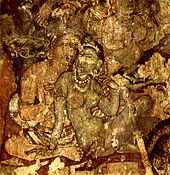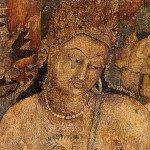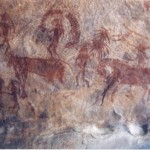History of India dates back to the beginning of Human civilization as long as 75,000 years ago, or with earlier hominids including Homo erectus from about 500,000 years ago, so we will classify the Indian History in below categories:
Ancient History of India

Ancient Indian painting
The earliest human remains found in South Asian parts, which are over 30,000 years old suggest existence of human civilization back then. Many of these evidences have been found in today’s India like Bhimbetka rock shelters in Madhya Pradesh. Available evidences also suggest usage of Iron, Copper and other metals was widely prevalent in this part of the world at a fairly early age, indicating progress which was made at that time. We will start discussions with below classifications: Top
Pre-Historic Stone Age(7000–3000 BC)

Bhimbetka rock painting , Madhya Pradesh, India
Isolated remains of Homo erectus in Hathnora in the Narmada Valley in central India indicate that India might have been inhabited since at least the Middle Pleistocene era, somewhere between 500,000 and 200,000 years ago. Tools crafted by proto-humans that have been dated back two million years have been discovered in the northwestern part of the subcontinent. The ancient history of the region includes some of South Asia’s oldest settlements and some of its major civilisations. The earliest archaeological site in the subcontinent is the palaeolithic hominid site in the Soan River valley. Soanian sites are found in the Sivalik region across what are now India, Pakistan, and Nepal. The Mesolithic period in the Indian subcontinent was followed by the Neolithic period, when more extensive settlement of the subcontinent occurred after the end of the last Ice Age approximately 12,000 years ago. The first confirmed semipermanent settlements appeared 9,000 years ago in the Bhimbetka rock shelters in modern Madhya Pradesh, India. Early Neolithic culture in South Asia is represented by the Bhirrana findings (7500 BCE)in Haryana, India & Mehrgarh findings (7000 BCE onwards) in Balochistan, Pakistan. Top Traces of a Neolithic culture have been alleged to be submerged in the Gulf of Khambat in India, radiocarbon dated to 7500 BCE. However, the one dredged piece of wood in question was found in an area of strong ocean currents. Neolithic agriculture cultures sprang up in the Indus Valley region around 5000 BCE, in the lower Gangetic valley around 3000 BCE, and in later South India, spreading southwards and also northwards into Malwa around 1800 BCE. The first urban civilisation of the region began with the Indus Valley Civilisation.
Pre-Historic Bronze Age(3000–1300 BC)
The Bronze Age in the Indian subcontinent began around 3300 BCE with the early Indus Valley Civilisation. It was centred on the Indus River and its tributaries which extended into the Ghaggar-Hakra River valley, the Ganges-Yamuna Doab, Gujarat, and southeastern Afghanistan. The civilisation is primarily located in modern-day India (Gujarat, Haryana, Punjab and Rajasthan provinces) and Pakistan (Sindh, Punjab, and Balochistanprovinces). Historically part of Ancient India, it is one of the world’s earliest urban civilisations, along with Mesopotamia and Ancient Egypt. Inhabitants of the ancient Indus river valley, the Harappans, developed new techniques in metallurgy and handicraft (carneol products, seal carving), and produced copper, bronze, lead, and tin. We will discuss some more about Harappan Civilization later in the article. The Mature Indus civilisation flourished from about 2600 to 1900 BCE, marking the beginning of urban civilisation on the subcontinent. The civilisation included urban centres such as Dholavira, Kalibangan, Rupar, Rakhigarhi, and Lothal in modern-day India, and Harappa, Ganeriwala, and Mohenjo-daro in modern-day Pakistan. The civilisation is noted for its cities built of brick, roadside drainage system, and multistoried houses. Top
The Indus Valley or Harappan Civilization (3000-2,500 BCE to about 1500 BCE)

Indus Valley ruins. This is a picture of Great Bath, Mohenjo Daro.
The History of India begins with the birth of the Indus Valley Civilization, more precisely known as Harappan Civilization. It flourished around 2,500 BC, in the western part of South Asia, what today is Pakistan and Western India. The Indus Valley was home to the largest of the four ancient urban civilizations of Egypt, Mesopotamia, India and China. Nothing was known about this civilization till 1920s when the Archaeological Department of India carried out excavations in the Indus valley wherein the ruins of the two old cities, viz. Mohenjodaro and Harappa were unearthed. The ruins of buildings and other things like household articles, weapons of war, gold and silver ornaments, seals, toys, pottery wares, etc., show that some four to five thousand years ago a highly developed Civilization flourished in this region. The Indus valley civilization was basically an urban civilization and the people lived in well-planned and well-built towns, which were also the centers for trade. The ruins of Mohenjodaro and Harappa show that these were magnificent merchant cities-well planned, scientifically laid, and well looked after. They had wide roads and a well-developed drainage system. The houses were made of baked bricks and had two or more storeys. The highly civilized Harappans knew the art of growing cereals, and wheat and barley constituted their staple food. They consumed vegetables and fruits and ate mutton, pork and eggs as well. Evidences also show that they wore cotton as well as woolen garments. By 1500 BC, the Harappan culture came to an end. Among various causes ascribed to the decay of Indus Valley Civilization are the invasion by the Aryans, the recurrent floods and other natural causes like earthquake, etc. [Read More ..]Top
Vedic civilization
The Vedic civilization is the earliest civilization in the history of ancient India associated with the coming of Aryans. It is named after the Vedas, the early literature of the Hindu people. The Vedic Civilization flourished along the river Saraswati, in a region that now consists of the modern Indian states of Haryana and Punjab. Vedic is synonymous with Aryans and Hinduism, which is another name for religious and spiritual thought that has evolved from the Vedas. The largely accepted view is that a section of Aryans reached the frontiers of the Indian subcontinent around 2000 BC and first settled in Punjab and it is here, in this land, where the hymns of Rigveda were composed. The Aryans lived in tribes and spoke Sanskrit, which belonged to the Indo-European group of languages. Gradually, the Aryans intermingled with the local people and a historic synthesis was worked out between the Aryan tribes and the original inhabitants. This synthesis broadly came to be known as Hinduism. The Ramayana and Mahabharata were the two great epics of this period. [Read More ..]
Top




You must be logged in to post a comment.